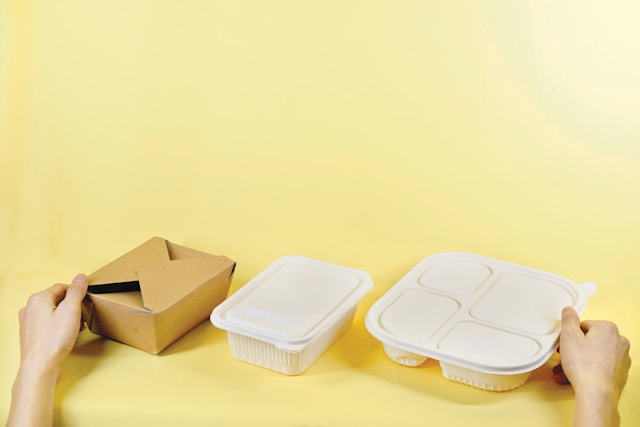- Change theme
Unveiling the Hidden Environmental Impact of Food Packaging

Food packaging plays a critical role in safeguarding our groceries as they journey from farms and factories to our tables
02:16 20 April 2024
In today’s consumer-driven society, food packaging plays a critical role in safeguarding our groceries as they journey from farms and factories to our tables. But while these materials keep food safe and fresh, they also bear a significant environmental cost. From production and usage to disposal, the lifecycle of food packaging contributes to pollution, waste, and resource depletion. This article delves into the hidden environmental impact of food packaging and explores sustainable alternatives that could pave the way for a greener future.
The Prevalence of Plastic Packaging
Plastic is the most common material used in food packaging. It’s lightweight, flexible, and impermeable to moisture and air, which makes it excellent for preserving food quality and extending shelf life. However, the production of plastics heavily relies on fossil fuels. About 4% of the world’s petroleum production is used to make plastic, and additional amounts are needed to power the manufacturing processes. Once disposed of, plastic packaging can take up to a thousand years to decompose, lingering in our environment as a persistent pollutant.
The Problem with Single-Use Packaging
Single-use food packaging, from plastic bags to Styrofoam containers, dominates the market due to its convenience. However, this convenience comes with a high environmental cost. Single-use items are typically used for minutes, yet they persist in the environment indefinitely. These products are major contributors to landfill waste and are often found in ocean debris, harming marine life and affecting the health of aquatic ecosystems.
Recycling Challenges
Recycling could be a viable solution to mitigate the impact of food packaging waste, but the reality is complex. Not all materials used in packaging are recyclable. Some plastics, like Styrofoam, are rarely accepted in municipal recycling programs. Moreover, food contamination in packaging can render some recyclable materials useless, as even small amounts of residue can disrupt the recycling process.
Carbon Footprint of Packaging Production
The environmental impact of packaging is not limited to waste and pollution; it also includes the energy consumed and the greenhouse gases emitted during production. The process of extracting raw materials, manufacturing packaging, and transporting it to various locations generates a significant amount of CO2, contributing to the overall carbon footprint of packaged goods.
Innovations in Biodegradable and Compostable Alternatives
As awareness of these issues grows, there has been a surge in interest in biodegradable and compostable packaging options. Materials such as PLA (polylactic acid) made from fermented plant starch (often corn) are gaining popularity. These materials can break down under the right conditions, offering a potential reduction in waste. However, they require specific industrial composting facilities to degrade properly, which are not available in all areas.
Reducing Packaging Through Refill and Reuse Models
Another sustainable approach is the development of refill and reuse models. Several supermarkets and brands are experimenting with systems that allow consumers to refill their own containers with products like cereals, nuts, and even detergents. This model significantly cuts down on the need for disposable packaging and encourages a shift towards a more sustainable consumption pattern.
The Role of Technology in Sustainable Packaging
Technological advancements are crucial in making food packaging more sustainable. For example, package seal detectors play an essential role in the packaging industry chain. These devices ensure that packaging seals are intact, preventing spoilage and waste of food products. Moreover, they help maintain the integrity of the packaging, which is crucial for the effective recycling or composting of materials. Ensuring that food packaging is properly sealed minimizes the risk of contamination and extends the product’s shelf life, thus reducing the environmental impact associated with waste.
Legislative Measures and Consumer Influence
Governments worldwide are beginning to legislate more stringent rules regarding packaging to push industries towards sustainable practices. Bans on specific types of single-use plastics are becoming more common. Consumer awareness and demand for sustainable products also drive change in the industry. As more people opt for products with eco-friendly packaging, companies are motivated to consider sustainable alternatives.
The Future of Food Packaging
The future of food packaging hinges on innovation, regulation, and consumer behavior. By investing in new materials, refining recycling processes, and embracing models that prioritize sustainability, we can significantly reduce the environmental impact of our packaging practices. The challenge and opportunity lie in balancing functionality and food safety with environmental responsibility.
In conclusion, while the task is daunting, the combined efforts of technology, policy, and informed consumer choices paint a hopeful picture for reducing the environmental footprint of food packaging. As we move forward, it is crucial for each stakeholder in the packaging and food industry chain to consider the long-term environmental effects of their decisions and strive towards more sustainable practices.
